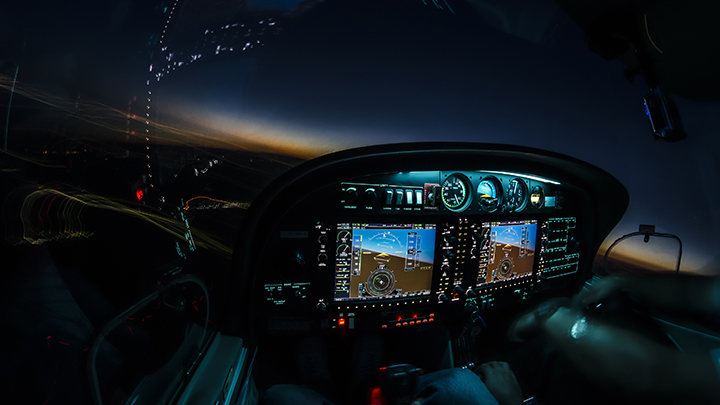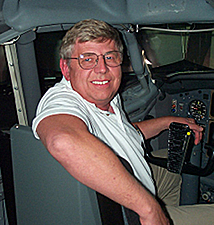The Pilots’ New Panel—Part II
By Michael J. “Mick” Kaufman
What is the perfect panel for your needs should you decide to do an upgrade? It depends on many factors.
Before we begin, I need to make a statement. A new panel will not make your airplane fly higher, faster, or safer –nor will it reduce your operating cost by finding cheaper fuel.
On the contrary, a study by the National Transportation Safety Board (NTSB) showed flat screen glass panels were not as safe as the standard six pack. I have personally found that when pilots fly manually, they can read and interpret the six pack much more easily than reading numeric tapes and synthetic vision displays.
A study conducted by McDonnell Douglas several decades ago confirms my statement, underscoring the fact that we can read and interpret the pointer on a conventual altimeter or airspeed much easier than a number on a tape.
| 734-961-3300 |

Part I [BPT TAKEOFF, April 2022] and the first paragraph of Part II [BPT TAKEOFF, May / June 2022] of the Captain’s Corner series was dedicated to embarrassing pilots who spent more for their new instrument panel than they originally paid for their aircraft, only to find out later that their new panel was no safer than that old six pack was.
It is time to recognize some great advancements made in the avionics world.
In my nearly sixty years of flying, I have seen many changes from the Narco Super Homer of my student pilot days to some great Garmin Avionics of today and maybe Dynon Avionics in the next generation. There were some avionics that can always be considered the Gold Standard–the King KX 170/175 of the 1960s and the Garmin 430 / 530 of the last decade.
Lectures Worth a Listen
I would recommend to our BPT pilots to listen to the lecture titled “Getting Away from Legacy Autopilots” presented by Bill Hale, Adrian Eichhorn and Jerry Stooksbury. This is one of the best presentation guides to avionics that I have seen, and it provides an insight as to what equipment to consider.
Another great BPT presentation, “The Aging Aviator” by Greg Ricca, compliments the above by adding in the human element and how it plays with our equipment. As a flight instructor who specializes in instrument ratings, recurrent training and equipment check-outs, I see how equipment and human factors react together.
It is interesting to note that about 75% of pilots flying with flight directors do not know how to properly use them. So how are they going to master the Garmin GFC 700 autopilot?
When Things Go South
While working on this series on avionics and instrument flying, I asked my mechanic, Roger Shadick, about system redundancy. I had just completed his flight review and IPC in his beautifully restored Globe Swift.
Roger’s comment was to turn off the master switch and see what equipment still functions. This is a thought for pilots who often comment on the problem with vacuum pump failure and why they want an all-electric equipped airplane with no vacuum pump.
In 21,000 hours, I have seen 3 vacuum pump failures – one of which was in IMC conditions. We expect vacuum pump failures on a dry pump between 500 and 700 hours as a rule – or replace them before they fail. I have a wet vacuum pump on my Bonanza, which will outlast several engines– mine has nearly 4,000 hours and has never been overhauled, nor has it failed. Think about this on an all-electric airplane in IMC conditions: one switch, one relay or one wire could be the weak point of your airplane.
When Cirrus introduced its aircraft, it threw all other aircraft manufacturers into a tailspin with the glass cockpit: two separate avionics busses, two alternators, two batteries and a ballistic parachute recovery system. I have delivered many new Cirrus airplanes from the factory and instructed the new owners. I adapted instantly to the glass display using airspeed and altitude tapes after flying the six pack forever. I concur that the scan and response time is not as good on the glass as on the six pack.
Likes & Dislikes of Avionics Equipment – and Why
As an instructor, I have seen and used most of the popular avionics currently in airplanes while flying with customers. The Garmin Aera 660 is probably the best piece of avionics for the dollar that I have ever spent — and I installed it in my Bonanza for about $800.00. This piece of equipment was recommended to me by my friend, Randy Bailey, as I had never heard of the unit or flown it before I bought it.
It is a portable unit but fits in the panel with the help of an Air Gizmo adapter. It provides most of the navigation and display functions of a Garmin 650 or 750 less VOR and comm functions and provides most of the GPS functions. It has an AHAR’s display, a base map, a sectional chart and IFR enroute charts as well as all approach charts. It talks to my Garmin GDL-52 which provides an Attitude and Heading Reference System [AHRS] and displays ADSB traffic, Sirius XM or ADSB weather via a hardwire link. The unit has Garmin CONNEXT like Flight Stream and provides an interface to transfer flight plans and data between my Garmin 480 navigator, the Garmin Aera 660 and Foreflight on my iPad via Bluetooth.
The Garmin Aera 660 together with the Garmin GDL-52 can also provide Sirius XM radio entertainment in the cockpit. In addition, the internal batteries that will provide approximately three hours of safe navigation and AHRS, should you turn off the master switch. Another positive goes to Garmin for the G-5 and GI-275 for their battery backup.
Giving up the redundancy of vacuum pump instruments to all electric instruments needs careful consideration as electrical failures are quite common; I have had several.
Here is a YouTube link I found covering the functions of the GI-275 and its redundancies. I have flown with several pilots having the GI-275 including my mechanic, Roger, who has one in his Globe Swift. Should I have a financial windfall, the GI-275 would find its way into my Bonanza.
With so much information available to the pilot, it is important to declutter the instrument of unneeded functions to keep from cluttering your brain. As we age, we are not as sharp as we were in our younger years. In doing a survey of pilots and instructors alike, my conclusion is if you are over the age of sixty and fly less than a hundred hours a year, I think it is better to stick with legacy avionics as you will never be able to learn and stay current with many of these complex boxes.
I also recommend pilots staying away from any avionics package that is a complete touch screen due to an experience I recently had trying to insert a waypoint in heavy turbulence in IMC conditions. I descended 1000 feet below my assigned altitude and came close to being added to the CFIT fatality list. Any pilot who disagrees with this has never been in severe turbulence. The Avidyne box allows the ease of both touch screen programing and knobs and buttons while in turbulence, which is a great idea!
The Pilot’s New Panel
If you should install that dream panel upgrade, I recommend getting some professional instruction on the use of your new equipment. There is no better place to get that training than from one of the qualified instructors in BPT.
In conclusion, here are some sage words to remember from the experts at Flight Safety, one of the most respected pilot training organizations in the business: “The best piece of safety equipment in your aircraft is a well-trained pilot.”
‘Til the next issue of Captain’s Corner, Fly Safe!
Michael J. “Mick” Kaufman




